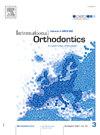含或不含纳米氧化锆的 3D 打印聚氨酯正畸托槽与传统金属和陶瓷托槽的摩擦阻力比较:体外研究
IF 1.9
Q2 DENTISTRY, ORAL SURGERY & MEDICINE
引用次数: 0
摘要
目的比较3d打印氧化锆纳米颗粒增强聚氨酯正畸托槽、3d打印聚氨酯正畸托槽、传统金属托槽和陶瓷托槽在体外环境下的摩擦阻力。方法采用立体光刻技术对聚合物正畸托槽和氧化锆增强聚合物正畸托槽进行3D打印。常规金属支架和常规陶瓷支架作为对照。在干燥条件下,使用滑动速度为1 mm/min的Instron万能试验机和50 n的测压单元测量支架与弯丝之间的摩擦力,采用Kruskal-Wallis检验和事后检验(Mann-Whitney U检验)进行统计分析(显著性水平P <;0.05)。结果3d打印氧化锆增强聚合物正畸托槽与3d打印聚合物正畸托槽之间无显著性差异。3d打印聚氨酯托槽的摩擦阻力最小(1.3895 + 0.72583 N),其次是3d打印氧化锆增强聚氨酯托槽(2.15 + 0.75683 N),其次是传统金属托槽(2.348 + 0.82682 N),而传统陶瓷托槽的摩擦阻力最大(4.9675 + 0.88519 N)。结论氧化锆纳米颗粒的掺入增加了3d打印聚合物正畸托槽的摩擦阻力。但这在统计学上并不显著。因此,氧化锆纳米颗粒可以被认为是一种更好的增强聚合物支架的临床应用。本文章由计算机程序翻译,如有差异,请以英文原文为准。
Comparison of the friction resistance of 3D-printed polyurethane orthodontic brackets with and without zirconium oxide nanoparticles with conventional metal and ceramic brackets: An in vitro study
Aim
To compare the frictional resistance of 3D-printed zirconium oxide nanoparticles reinforced polyurethane orthodontic brackets, 3D-printed Polyurethane orthodontic brackets, conventional metal and ceramic brackets in an in vitro environment.
Methods
Stereolithography was used to 3D print the polymer orthodontic brackets and zirconium oxide-reinforced polymer orthodontic brackets. Conventional metal brackets and conventional ceramic brackets were used as controls. The frictional force between the bracket and the archwire was measured under dry conditions with an Instron universal testing machine with a sliding velocity of 1 mm/minute and a load cell of 50 N. The Kruskal-Wallis test with post hoc test (Mann-Whitney U test) was used for statistical analyses (significance level P < 0.05).
Results
There is no significant difference observed between 3D-printed zirconium oxide-reinforced polymer orthodontic brackets and 3D-printed polymer orthodontic brackets. The frictional resistance was found to be the least in 3D-printed polyurethane brackets (1.3895 + 0.72583 N), followed by 3D-printed zirconium oxide-reinforced polyurethane brackets (2.15 + 0.75683 N), conventional metal brackets (2.348 + 0.82682 N), and it was highest in conventional ceramic brackets (4.9675 + 0.88519 N).
Conclusions
The incorporation of zirconium oxide nanoparticles increased the frictional resistance of 3D-printed polymer orthodontic brackets, but it was not statistically significant. Hence, zirconium oxide nanoparticles could be considered as a better reinforcement for polymer brackets for enhanced clinical utility.
求助全文
通过发布文献求助,成功后即可免费获取论文全文。
去求助
来源期刊

International Orthodontics
DENTISTRY, ORAL SURGERY & MEDICINE-
CiteScore
2.50
自引率
13.30%
发文量
71
审稿时长
26 days
期刊介绍:
Une revue de référence dans le domaine de orthodontie et des disciplines frontières Your reference in dentofacial orthopedics International Orthodontics adresse aux orthodontistes, aux dentistes, aux stomatologistes, aux chirurgiens maxillo-faciaux et aux plasticiens de la face, ainsi quà leurs assistant(e)s. International Orthodontics is addressed to orthodontists, dentists, stomatologists, maxillofacial surgeons and facial plastic surgeons, as well as their assistants.
 求助内容:
求助内容: 应助结果提醒方式:
应助结果提醒方式:


